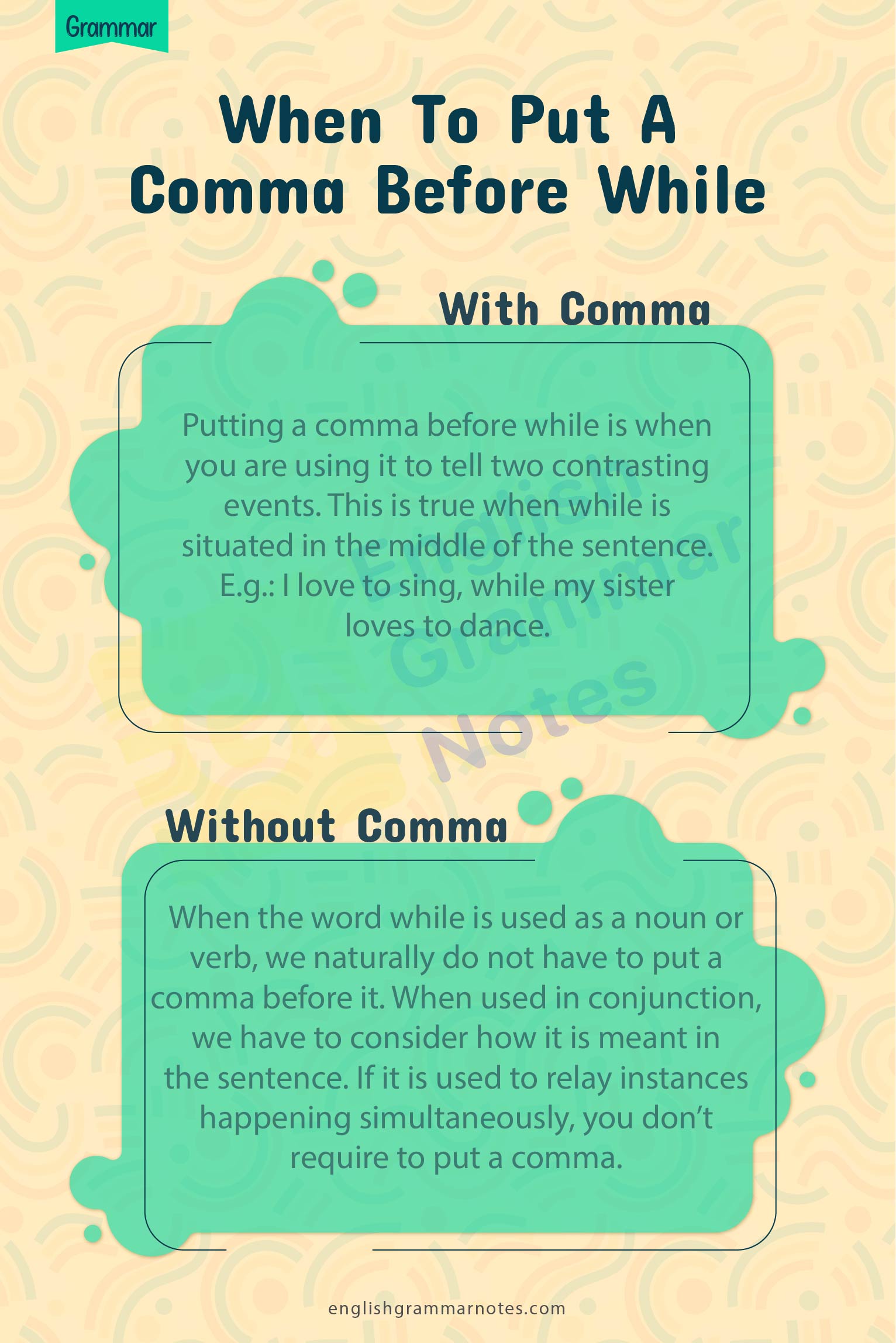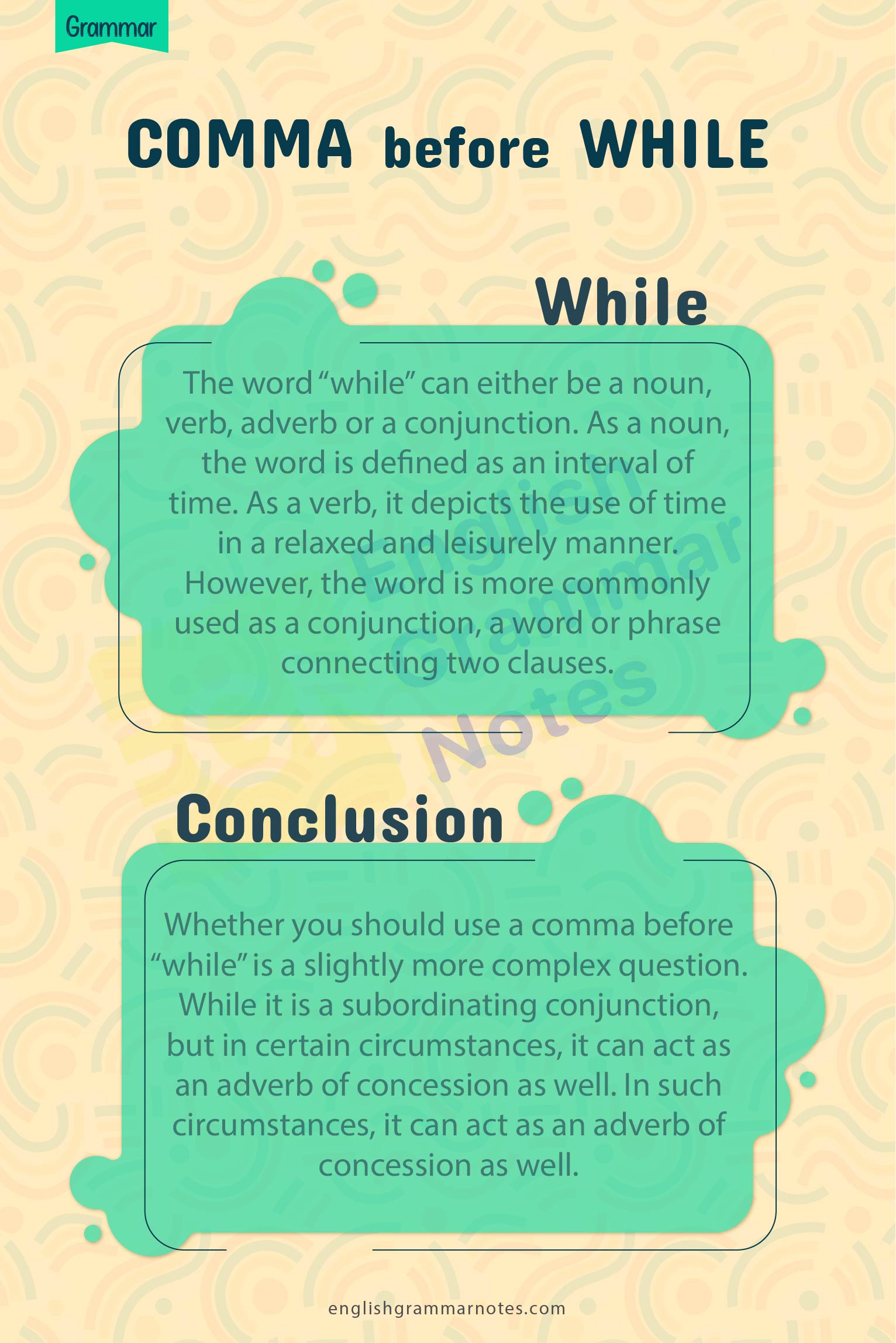Comma Before While: A comma gets tricky in the placement of sentences. If placed incorrectly, the entire meaning of the text could get altered. This makes it essential to know the rules on when and how to incorporate commas in the sentence that you wish to convey. To make the sentence understood, it is necessary to place the punctuation marks in the right place. There are many rules for using a comma appropriately. Commas can become a frustrating grammatical concept even for native speakers. This makes the right placement even more important in the sentence, or it might change the entire meaning of the sentence. With the right understanding, we can navigate through punctuation marks, particularly commas, which can get very tricky at times for users. One of them is when to use a comma before a while. In this article, we will focus on using a comma before “while”.
- Definition of “While”
- When To Put A Comma Before While
- When Should You Not Put A Comma Before While
- Conclusion on Comma Before While
- FAQ’s on Comma Before While
Definition of “While”
The word “while” can either be a noun, verb, adverb or a conjunction.
As a noun, the word is defined as an interval of time. As a verb, it depicts the use of time in a relaxed and leisurely manner. However, the word is more commonly used as a conjunction, a word or phrase connecting two clauses. In such a context, the term while has two probable purposes. It can be used to describe incidents happening at the same time. It may also be used for connecting contrasting ideas or situations in one sentence. “While” as a conjunction is often misused, especially with its association with commas. The judgement on this concern generally depends on how the word while is being used in the sentence.
When To Put A Comma Before While
With Comma
Putting a comma before while is when you are using it to tell two contrasting events. This is true when while is situated in the middle of the sentence. One way to easily recognize this rule is by replacing the word while with although or whereas. If the sentence’s meaning is the same after replacement, then the comma is being placed right. Not putting a comma when you want to contrast ideas will change readers’ way it is being read. This could create confusion or misinterpretation in the sentence.
Here are some examples showing the proper use of a comma before the word while.
I love to sing, while my sister loves to dance.
The one that got away left, while the one that came next stayed.
Jenny is excited to ride the roller coaster, while Penny is nervous and afraid.

When Should You Not Put A Comma Before While
Without Comma
When the word while is used as a noun or verb, we naturally do not have to put a comma before it. When used in conjunction, we have to consider how it is meant in the sentence. If it is used to relay instances happening simultaneously, you don’t require to put a comma.
Try replacing the word while with as and see if the sentence’s meaning appears to be the same. If it does, then it is right not to place a comma. Also, we don’t put a comma before while at the beginning of the sentence. However, it is required to put one at the end of the clause that it introduces.
Some sentences using the word while without a comma
I was singing while my sister was dancing.
Penny shouts her tongue out while riding the roller coaster.
The one that got away left while she was working abroad.
Conclusion on Comma Before While
Whether you should use a comma before “while” is a slightly more complex question. While it is a subordinating conjunction, but in certain circumstances, it can act as an adverb of concession as well. In such circumstances, it can act as an adverb of concession as well. In such a circumstance, it should have a comma before it.
If we replace while with as then, it shouldn’t have a comma or normal subordinating conjunction. Replacing “while” with “whereas” should use a comma before it because it is being used as an adverb of concession.

FAQ’s on Comma Before While
Question 1.
What are the 8 rules for commas?
Answer:
The eight primary uses for commas are
- A comma is used after an introductory clause or phrase.
- A comma is used to separate independent clauses.
- A comma is used between all items in a series.
- A comma is used to set off nonrestrictive clauses.
- A comma is used to set off appositives.
- A comma is used to indicate a direct address.
- A comma is used to set off direct quotations.
Question 2.
What are the 5 Rules of commas?
Answer:
The five comma rules to follow are
- A comma is used to separate items in a series.
- A comma is used after an introductory phrase or clause.
- A comma is used before and after a parenthetical phrase or clause.
- Use a comma to separate two independent clauses linked by a coordinating conjunction (and, but, for, nor or, so, yet)
Question 3.
How do you put a comma in a sentence?
Answer:
Commas not only signify pauses in a sentence. The precise rules decide when to use this punctuation mark. Commas are needed before coordinating conjunctions, after dependent clauses (when they precede independent clauses), and to set off appositives.
Question 4.
What is the word “while”?
Answer:
The word “while” can either be a noun, verb, adverb or a conjunction.
As a noun, the word is defined as an interval of time. As a verb, it depicts the use of time in a relaxed and leisurely manner. However, the word is more commonly used as a conjunction, a word or phrase connecting two clauses. In such a context, the term while has two probable purposes. It can be used to describe incidents happening at the same time. It may also be used for connecting contrasting ideas or situations in one sentence. “While” as a conjunction is often misused, especially with its association with commas. The judgement on this concern generally depends on how the word while is being used in the sentence.
Question 5.
When should you put a comma before the word “while”
Answer:
Putting a comma before while is when you are using it to tell two contrasting events. This is true when while is situated in the middle of the sentence. One way to easily recognize this rule is by replacing the word while with although or whereas. If the sentence’s meaning is the same after replacement, then the comma is being placed right. Not putting a comma when you want to contrast ideas will change readers’ way it is being read. This could create confusion or misinterpretation in the sentence.
Question 6.
What is an example of a sentence using a comma before the word “while.”
Answer:
The man left the restaurant, while [whereas] his friend stayed.
Question 7.
When should you not put a comma before the word “while.”
Answer:
When the word while is used as a noun or verb, we naturally do not have to put a comma before it. When used in conjunction, we have to consider how it is meant in the sentence. If it is used to relay instances happening at the same time, then you don’t require a comma.
Try replacing the word while with as and see if the sentence’s meaning appears to be the same. If it does, then it is right not to place a comma. Also, we clearly don’t put a comma before while at the beginning of the sentence. However, it is required to put one at the end of the clause that it introduces.
Question 8.
What is an example of a sentence not using a comma before the word “while.”
Answer:
The man left the restaurant while [as] it was raining.
Question 9.
How to use comma in whereas?
Answer:
The general rule of thumb is When two things are contrasted, use a comma. “Whereas” is generally used to contrast two things:
In the sentence, I am very tall, whereas my wife is quite short.
Notice in the sentence how the clause after “whereas” is a non-essential piece of additional information (“I am very tall” means the same, no matter what the “whereas” clause says).
Some authors do not precede “whereas” followed by a comma, which is found rather unfortunate. The comma here improves legibility and better represents speaking (there is usually a pause before “whereas”).
The word “Whereas” is also used in legal documents in the sense of “because”. Unless you are practising law, you don’t have to worry about this.
“Whereas” is an example of “adverbs of concession,” along with “though” and “even though”. These words are used where a dependent clause contrasts with the main clause. A comma should be used to introduce a dependent clause that starts with an adverb of concession.